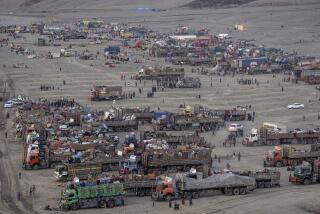Weather Likely to Prolong Mission
- Share via
WASHINGTON — Some Pentagon officials said Friday that winter conditions, a perennial curse to armies in Afghanistan, soon could affect U.S. military operations in the country.
Even as Rear Adm. John D. Stufflebeem insisted in a briefing that “we are an all-weather force,” other officials said privately that the advent of snow and bitter cold will hamper or slow bombing, logistics and helicopter-borne operations. “It will be a factor,” one official said.
The specter of weather complications came at the close of a week in which U.S. officials have acknowledged that they are struggling with a dogged foe, weak military allies and public relations problems caused by civilian deaths in errant bombings. All these factors increase the chances that the Afghanistan campaign will prove protracted.
Although temperatures in the southern city of Kandahar were in the high 80s on Friday, snow is already collecting in mountain passes elsewhere in the country. Heavy snows typically begin limiting movements on the ground by mid- or late November; eventually, temperatures in parts of Afghanistan could fall to well below zero.
U.S. forces have some advantages that earlier armies that waged war in Afghanistan did not. Potential ground operations would be conducted by specially trained commandos moving in small numbers, rather than larger, heavier ground forces. Also, many of the supplies for these forces would be provided by aircraft.
Even so, fog, snow and strong winds will complicate air operations and could significantly slow Afghan opponents of the ruling Taliban who are already fighting the regime on the ground, say defense experts and retired military officers.
About 80% of the country is mountainous. The northern region, where U.S. allies are concentrated, is especially affected by cold conditions.
Stufflebeem, a senior official of the Joint Chiefs of Staff, noted that the weather has not prevented any flights so far.
He also sought to rebut the arguments of domestic critics and some Afghan allies that the U.S. forces should be pounding the Taliban front-line positions far harder than they have been. Some analysts in the United States contend that U.S. commanders, for example, should be sending B-52 bombers with hundreds of gravity bombs to decimate Taliban positions north of Kabul, the capital, and near the strategic northern city of Mazar-i-Sharif.
“I don’t personally believe we are getting bogged down,” Stufflebeem said. “This is not a traditional force-on-force operation.”
Defense officials say Taliban troops are spread out and entrenched in ways that probably would make use of the B-52s ineffective. U.S. commanders say that rather than wasting bombs on moving targets, U.S. forces can do more damage by taking out the Taliban’s infrastructure and the logistical tools it needs to keep its military running and reinforced: transport, fuel, ammunition, vehicles, communications.
One official, invoking an often-cited military dictum, said that while military amateurs debate tactics, professionals “think logistics.” Defense officials contend that systematic strikes on the targets the U.S. forces have chosen will eventually immobilize the Taliban. They assert that it is already apparent that the Taliban is struggling to reinforce its troops in the northwestern corner of the country.
As bombing continued over Kabul on Friday, despite the Islamic day of prayer, Pentagon officials said U.S. warplanes had inadvertently dropped bombs on Red Cross warehouses in Kabul, the Afghan capital, for a second time.
Red Cross officials in Pakistan said the strikes set three warehouses on fire. They said the warehouses contained food, blankets, tents and other relief supplies.
Although the warehouses were seriously damaged, it was unclear how much of the contents were lost. Officials from the organization said the buildings are clearly marked with red crosses.
The British government announced Friday that it was sending 200 special forces troops into action with U.S. troops in Afghanistan.
Armed Forces Minister Adam Ingram told Parliament that 200 commandos of the Royal Marines would be based on assault ships in the region, ready for operations in Afghanistan.
He also said an armada of ships led by the aircraft carrier Illustrious would be switched from exercises in Oman, ending this weekend, to positions closer to Afghanistan.
About 4,200 troops and support personnel, a submarine armed with cruise missiles, a destroyer and a frigate, plus seven Royal Fleet auxiliary ships and four support aircraft will be deployed in the area. Patrol and cargo aircraft also will be part of the package.
The deployments come on top of the military support already given to the U.S. operation--air-to-air refueling and reconnaissance aircraft, the use of the military base on the Indian Ocean island of Diego Garcia, and two submarines with the ability to fire Tomahawk missiles.
Prime Minister Tony Blair said it was vital for Britain to contribute ground forces.
“It’s a huge responsibility to commit our armed forces, but in my view it is justified in circumstances where our people are at risk,” he told British Forces Radio.
In Tashkent, Uzbekistan, a leader of the anti-Taliban Northern Alliance said Friday that there has been heavy fighting near the northern Afghan town of Shulgar, about 30 miles south of Mazar-i-Sharif. The alliance has been waging an offensive for control of Mazar-i-Sharif, which sits at a key northern crossroads.
The United States bombed the Taliban front lines in the area Wednesday and Thursday, killing some Taliban troops, said Ibrahim Ghafoori, an official of the Afghan government-in-exile at its Tashkent embassy.
*
Richter reported from Washington and Miller from London. Staff writers Richard C. Paddock in Uzbekistan and Tyler Marshall in Pakistan and researcher Janet Stobart in The Times’ London Bureau contributed to this report.
More to Read
Sign up for Essential California
The most important California stories and recommendations in your inbox every morning.
You may occasionally receive promotional content from the Los Angeles Times.














